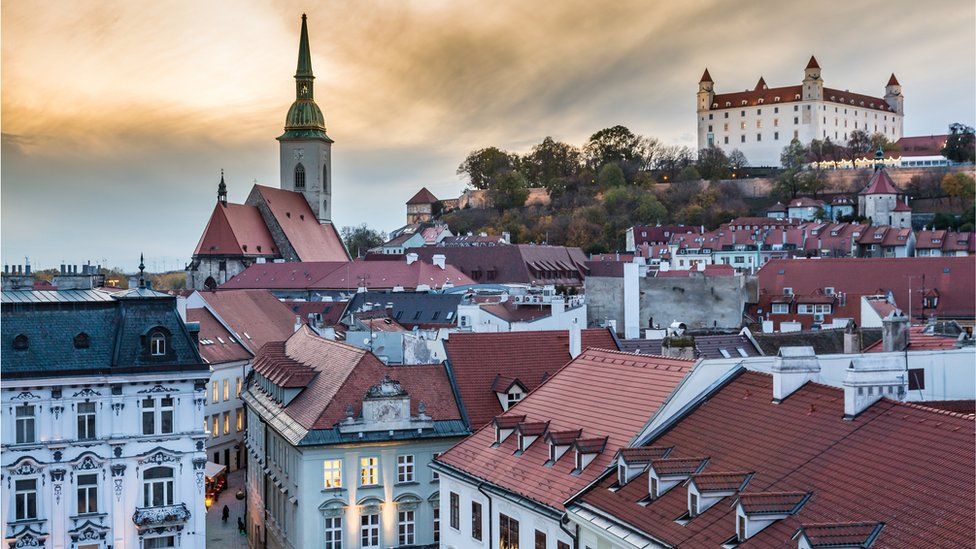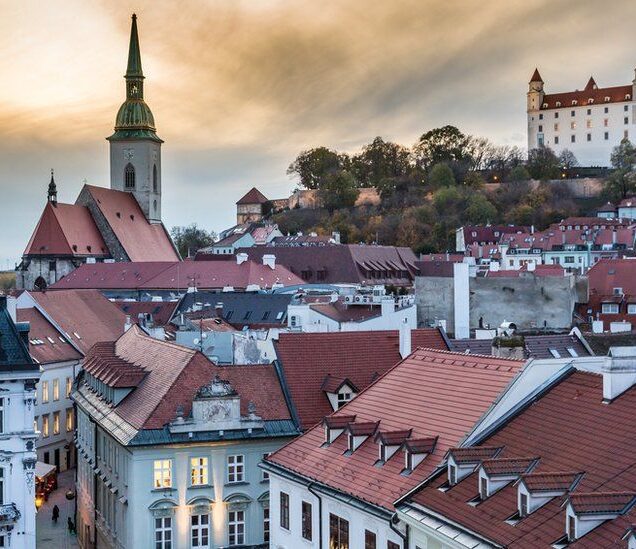

Take a Slovakia adventure tour to discover this little known pearl of Eastern Europe dotted by glittering lakes, rivers and verdant forests. Travel to Slovakia and enjoy exploring it’s cultural capital city of Bratislava, which is considered one of the most underrated cities to visit in Europe.

After settlements by Celtic peoples, the region where Slovakia now lies was conquered by the Romans, before the land passed into the hands of the Great Moravia Empire. The city of Bratislava came into being in 1919 and was known before then as Pressburg (for German speakers) and Pozsony (for Hungarians). Under Hungarian rule, Bratislava became the Coronation city and capital of the Kingdom of Hungary and the city was well patronised by wealthy aristocrats and businessmen who built grand palaces. Great musicians and composers such as Haydn, Mozart and Beethoven lived in the city and added to its cultural flavour. The Czechoslovak Republic was first formed when Slovak and Czech nations sought to unite and repel the Austro-Hungarian Empire. During World War I the leaders set the country up as a fascist state, however this was not popular, leading to an ill-fated political uprising. Hitler annexed the country just before World War II and the Russians invaded shortly after the war, taking Czechoslovakia under the Soviet Union’s wing. After the fall of communism in 1989 and the dissolution of the Soviet Union.
the Slovak Republic peacefully parted from its neighbour the Czech Republic in what is famously known as the ‘Velvet Divorce’ of 1993 and became known as Slovakia. Slovakia joined the European Union and the NATO in 2004, and finally the euro zone on 1 January, 2009.
The Slovak Republic is situated in central Europe, landlocked by the Czech Republic, Austria, Poland, Hungary and Ukraine. The republic is famous for its year-round natural beauty owing to a combination of mountains, lowlands, canyons, lakes, cave formations, forests and meadows. Much of the country is dominated by the Carpathian Arc – a range of mountains stretching across the north, the Lesser Carpathians, White Carpathians, Malá (Lesser) Fatra, Vel’ká (Greater) Fatra, High and Low Tatras and the Slovak Ore Mountains.
Slovakia has a damp continental climate making the weather changeable. Summers are often warm but interrupted by sudden thunderstorms. The warmest month is often July with the driest regions being the southern lowlands
Visit www.worldclimate.com to get an idea of what the weather will be like on your tour.
A valid passport (a minimum of 3 months) is required for entry. Non-EU nationals may need to provide proof of funds for the duration of their stay and this may be checked by customs. You should also be able to show a copy of your return ticket if requested. US citizens staying overnight in Slovakia must register with the local police within three working days. When staying at hotels you are registered automatically. The Slovak Republic joined the Schengen Agreement for overland entry points, seaports and airports.
Most other nationalities do not require a visa. However visa regulations change frequently so it is important you consult with the embassy prior to travelling to ensure you have the correct visas. In some cases you will be crossing the borders on overnight trains and without the correct visa for your nationality you will not be allowed to enter the country and will be asked to leave the train. It is the responsibility of the traveller to obtain all correct visas needed prior to departure.
Visa services like www.travcour.com can be very helpful.
Slovakia is in the euro zone. For up to date exchange rates with your own currency visit www.oanda.com or www.xe.com.
ATMs are widely available in most towns and cities. Most major currencies can be exchanged at banks and bureaux de change, hotels and in travel agencies. Major Credit cards are widely accepted. Traveller’s cheques are accepted in banks and at bureaux de change. To avoid additional exchange rate charges, travellers are advised to take traveller’s cheques in US dollars or pounds sterling.
In Bratislava and other towns you will find buses, trolleybuses and trams. Tickets are sold from kiosks. One of the most popular and reliable ways of getting around on your own in large cities in is by taxi. Try to find out what the going rate for journeys is before you hop in to ensure you are not being overcharged – only some taxis will have meters. You will also find that fares increase at night. Your tour leader will be able to provide advice on this in each major city.
In the Tatras Mountains you will find an electric tram/railway network and one major road connecting many of the villages. Other excellent ways to get around are the funicular railway, cable car and of course you can experience the amazing scenery on foot.
It is customary to give a 5-10 % tip if you are happy with the service. (If you are unsure your tour leader will advise a suitable amount). Tipping guides at the end of excursions is always appreciated and your tour leader will advise you on the amount for this.
Generally people find Slovakia to be safe and feel confident wandering alone during the day. However if you are unfamiliar with an area it is recommended that you exercise more caution at night and taxi taxis rather than walk, especially if you are a lone female traveller. In some cities bag snatching can occur so always keep a firm hand/eye on your personal items.
Slovak food is similar to Czech fare but Hungarian influences are also strong. Keep a look out for the Slovak national dish bryndzové haluisky which is gnocchi with a thick sheep’s-cheese sauce and crumbled grilled bacon. Other specialities include mutton with sauerkraut, flavored with prunes, mushrooms and apples, cabbage leaves filled with minced meat, served with a milky sauce, sulance (potato dough turnovers filled with plum jam). Goulash is popular (although a mild stew rather than the authentic spicy soup), langose is a deep-fried dough smothered in a variety of toppings.
Cake shops can be found throughout Slovakia and are considered an important part of the country’s social life. Coffee is drunk black – espresso style. Icecream is also popular and can be purchased from window kiosks in the sides of buildings.
Keep a look out for Slovakian white wine and borovicka (strong gin). The home production of brandy is a popular national pastime; the most famous is a plum brandy (slivovice). Locally made beers and lagers are served in most bars and cafes.
All drinks such as bottled water or soft drinks are at your own expense at all times and are fairly inexpensive. Alcoholic drinks vary in price, with wine and beer generally being the cheapest options. The legal drinking age is 18. You should avoid drinking in the street unless at a festival or you will be fined.
220 volts / 50 Hz. European-style two-pin plugs are in use.
GMT/UTC +1. For other time differences please visit www.timeanddate.com
The Trans Mongolian Railway holds a certain mystique for adventure travellers. It’s one of the classic overland routes like the…
‘After you’ve finished we can take a pletna out to Bled Island.’ She said smiling. ‘There’s no rush is there?’…
When you think of Romania the first thing that comes to a lot of peoples’ minds is Transylvania and Dracula.…
We are passionate adventure travelers who want to share the world and our travel experiences with everyone…
This website uses cookies so that we can provide you with the best user experience possible. Cookie information is stored in your browser and performs functions such as recognising you when you return to our website and helping our team to understand which sections of the website you find most interesting and useful.
Strictly Necessary Cookie should be enabled at all times so that we can save your preferences for cookie settings.
If you disable this cookie, we will not be able to save your preferences. This means that every time you visit this website you will need to enable or disable cookies again.
